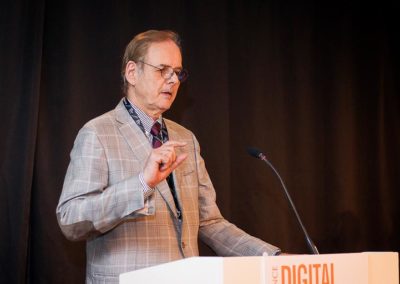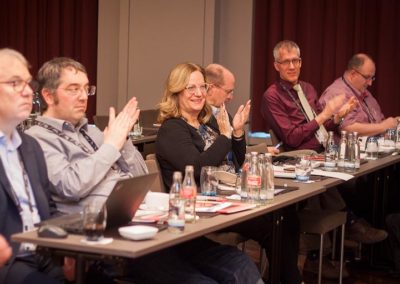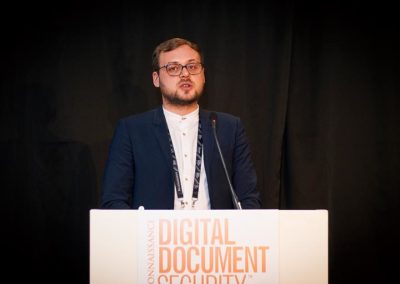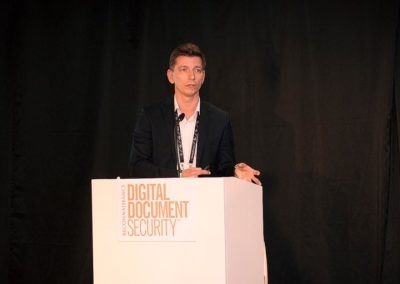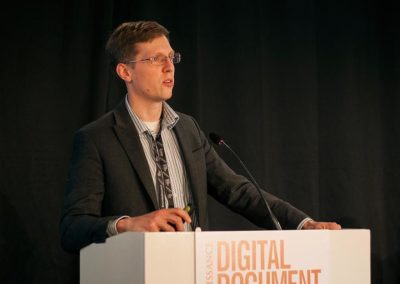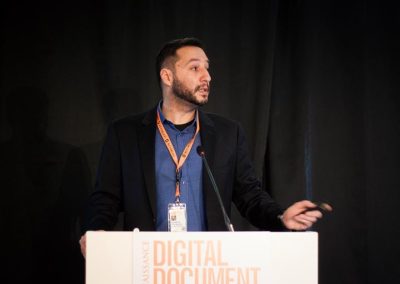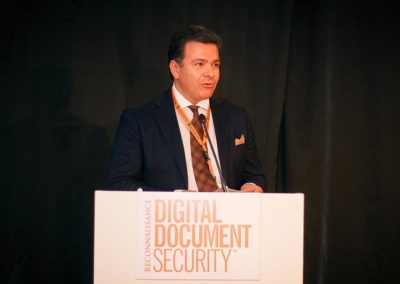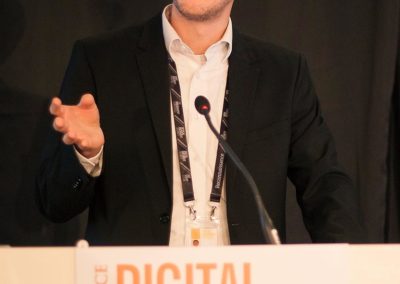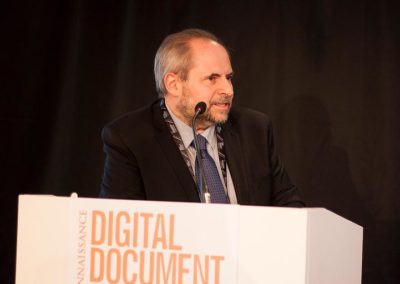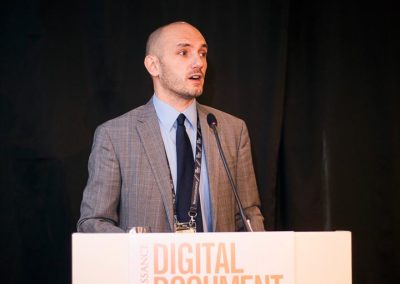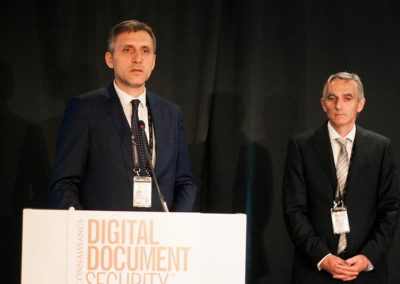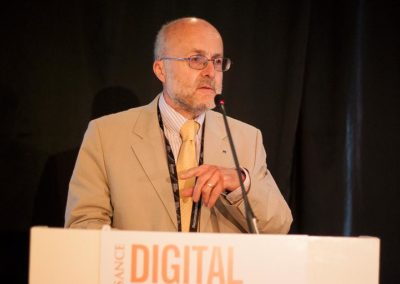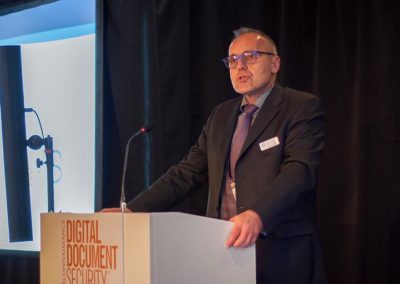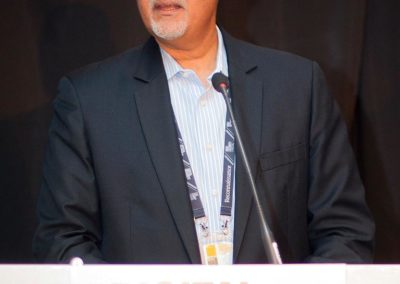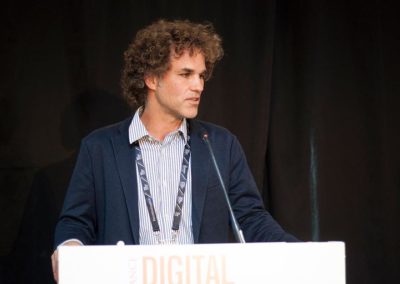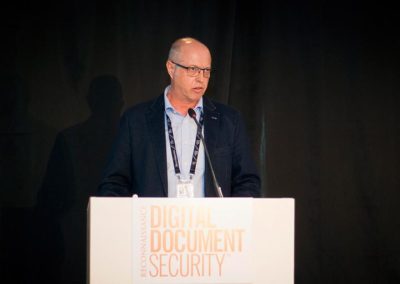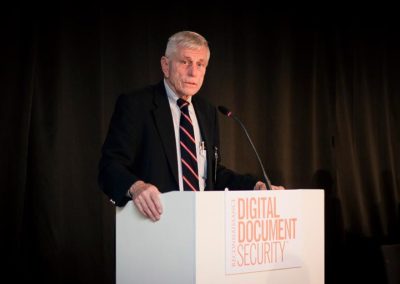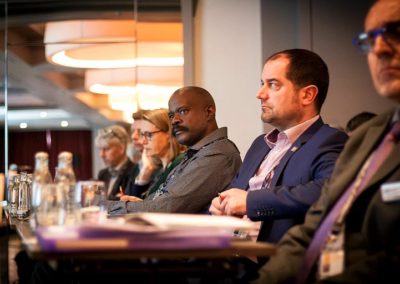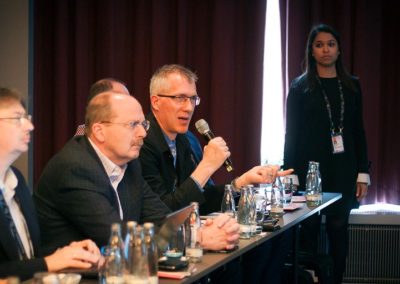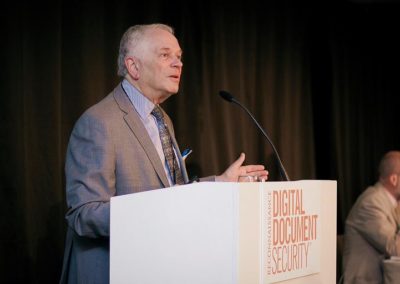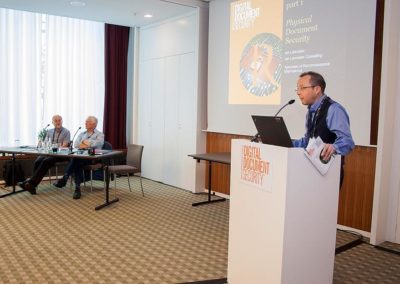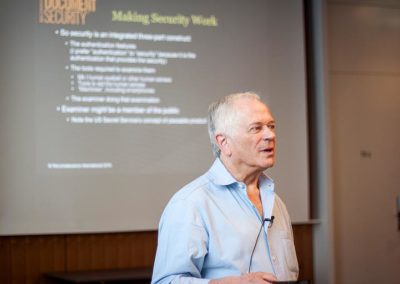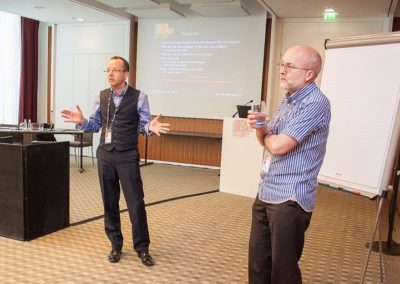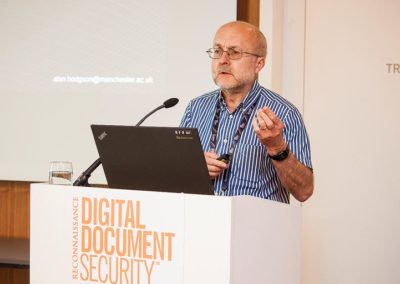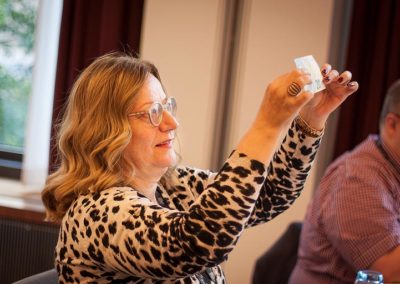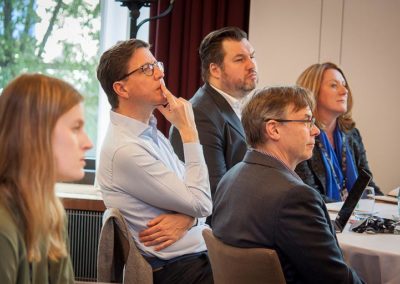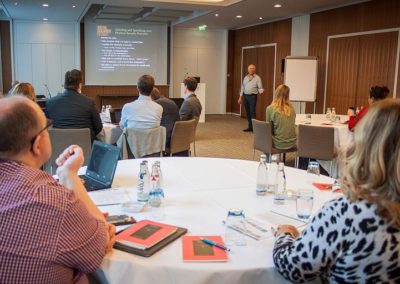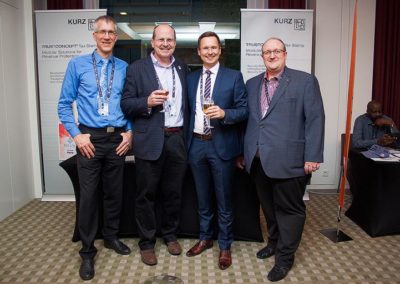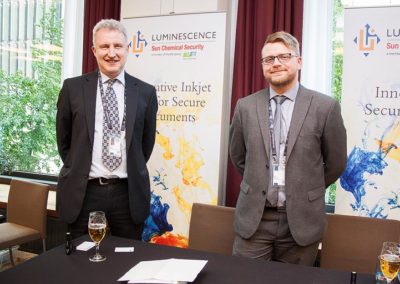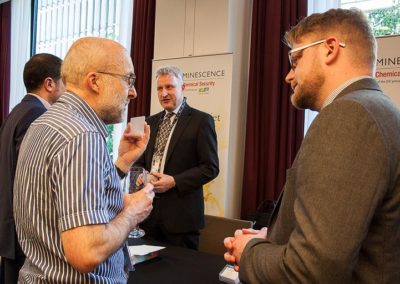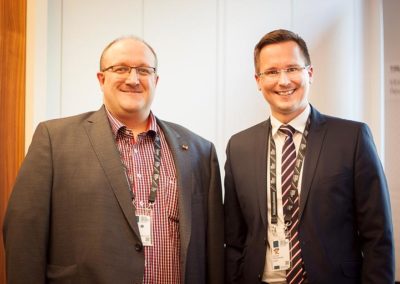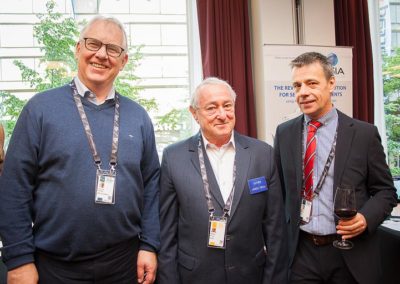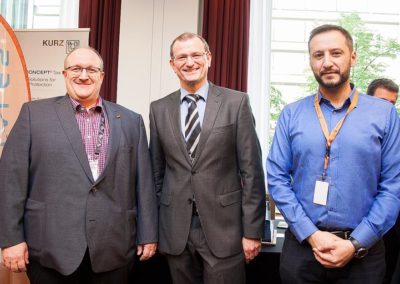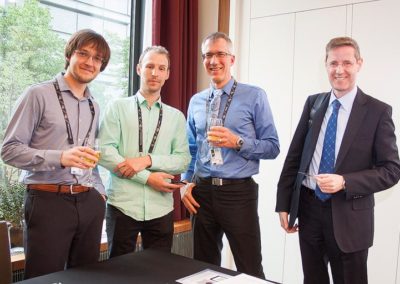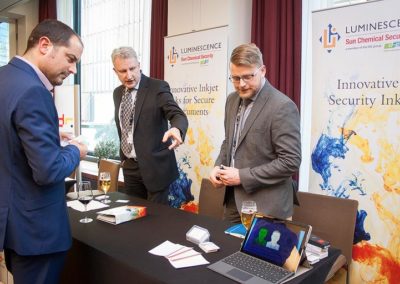Attendee's Geolocation
DDS 2019 Review – Berlin
Conference Review
Attendees were drawn from government banknote and ID issuing and enforcement agencies, from established security document providers – including Bundesdruckerei, Goznak, SICPA and Orell Füssli – from universities and research institutes, and from the new field of digital transaction and ID systems, such as Google, Veridos and Scytáles (see below the list of attendees).
The conference examined the transition from physical secured documents –for example, banknotes and identity documents – to digital methods for financial transactions and storing identity credentials. Whilst acknowledging the disruptive nature, convenience and vulnerabilities of purely digital methods, the conference also looked at whether the two domains of physical and digital can co-exist, and if so how.
The safety and security of digital identity and financial transactions was the underlying theme to emerge from the presentations and discussions. Dr Mark Deakes, Director of Optical and Authentication Technologies at Reconnaissance, gave an introductory paper explaining the DDS context and the thinking behind it. This was followed by a keynote paper from Ian Lancaster, DDS Co-Chairman, in which he pointed out that physical secured documents have a thousand-year history, giving a wealth of experience to the issuers, producers and examiners, so items such as banknotes and passports now have a high level of protection built in. One result is that the number of counterfeit banknotes and the incidence of fraudulent passports have been falling, but it also leads to the high level of public trust in these and similar documents. He also pointed out that the move to digital systems for transactions and ID represents a shift in the balance of power, from issuers (often government agencies) to the public, who own and control what is on their smartphones.
A question examined at DDS is whether digital systems can match this level of security and gain the same level of public trust. Several presenters showed how their digital ID, such as Kosovo’s recently rolled out digital driving licence – a system developed by Veridos – or transactional systems work and their built-in security, while presenters from newer companies that specialise in digital systems’ security focussed on their specific approach.
Delegates acknowledged the fragility of public trust, identified in a presentation by Dr Alan Hodgson, Co-Chairman of the Conference, who pointed out that “trust takes a long time to build and no time to destroy.” On the other hand, a key driver for digitalisation is public convenience, although this convenience may jeopardise or compromise security.
Micaal Sidorov, editor of Reconnaissance’s ID & Secure Document News, surveyed the global trend to digital and eID systems, the sub-text being that we are past the tipping point in the move from physical to digital. This didn’t prevent delegates from expressing their concerns regarding the security of such systems, given the large number of hacking and ID theft cases now being reported.
Delegates also supported calls – led by Dr Hodgson – for the introduction of international standards covering identity and payment data stored on smartphones and other portable devices. These standards would span the characteristics, security and interoperability of digital driving licences, other ID documents and bank and credit card data. A technical paper on this topic, published by the IEC, was presented at DDS.
At the end of the first day of the conference a buffet dinner was held at which there were nine table-top exhibits. This was an opportunity for exhibitors (Bundesdruckerei, INPI Asia, Jura, Krypten, Leonhard Kurz, Luminescence, Document Security Alliance, Scytales, Signe) to show delegates the products and systems that were being discussed in the event, holding one-to-one conversations to demonstrate or explain these features and systems.
The two-day conference was preceded by a half-day short course under the title Digital and Physical, Does One Plus One Equal Three? Ian Lancaster gave an overview of the basics of physical document security, following by a similar overview of digital document security by Alan Hodgson. This led to a discussion around the 1+1=3 question, when participants recognised the inevitability of the growth of digital methods, expressed their concern at the monopoly power this is allowing and the vulnerability of networks, while concluding that there is great potential for the use of digital systems and physical documents to operate together.
Response to the conference was overwhelmingly positive. It is the only event that focuses on the security of the document and the concomitant personal information in this fast-moving field, so participants called for it to be held again in a year’s time, some even recommending their country or region as the location for the next event.
inIT-Institute Industrial IT
Bundesdruckerei
ANY Security Printing
Luminescence SunChemical Security
M.J.M. International
Lebanese American University
Attendees
AJW Inc
USA
Alan Hodgson Consulting
United Kingdom
Andrews & Wykeham Ltd
United Kingdom
ANY Security Printing Company PLC
Hungary
Authentix Inc
USA
Banco de España
Spain
Bank Al-Maghrib
Morocco
Bank Note Paper Mill India Pvt Ltd
India
Beijing Boda Green High-Tech Limited
China
Bundesdruckerei GmbH
Germany
Central Bank of Somalia
Somalia
Colorado State University
USA
CSEM SA Basel
Switzerland
De La Rue
United Kingdom
Deutsche Bundesbank
Germany
DILETTA Maschinentechnik GmbH
Germany
DNP Imagingcomm Europe B.V.
Netherlands
European Central Bank
Germany
Google UK Ltd
United Kingdom
Grafica Latina Srl
Argentina
HID Global
United Kingdom
Hueck Folien GmbH
Austria
In-Core Systèmes
France
inIT – Institute Industrial IT
Germany
INPI Asia
Singapore
Institute for Computer Science, Freie Universität Berlin
Germany
Intergroup Partners AG
Switzerland
Joint Stock Company Goznak
Russia
JSC RPC Krypten
Russia
Jura JSP GmbH
Hungary
KBA-NotaSys SA
Switzerland
Lake Image Systems Ltd
United Kingdom
Lebanese American University
Lebanon
Leonhard Kurz Stiftung & Co KG
Germany
Luminescence Sun Chemical Security
United Kingdom
M.J.M. International (Aust) Pty Ltd
Australia
Ministry of Interior – Austria
Austria
Ministry of Internal Affairs – Kosovo
Kosovo
Ministry of Works & Transport, Uganda
Uganda
National Bank of Belgium
Belgium
National Bank of Greece
Greece
National Identification Authority (Ghana)
Ghana
ONEPROVE
Czech Republic
Onfido
United Kingdom
Orell Füssli Security Printing Limited
Switzerland
OVD Kinegram AG
Switzerland
Papierfabrik Louisenthal GmbH
Germany
Polestar Limited
USA
Polygraph Combine “Ukraina”
Ukraine
Prismade Labs GmbH
Germany
Regula Baltija Ltd
Belarus
Reneant Solutions Ltd
Ghana
ScanTrust SA
Switzerland
Schreiner Group GmbH & Co KG
Germany
Science Media Partners
United Kingdom
Scytáles AB
Sweden
Shriro Trading Company Ltd
Japan
SICPA SA
Switzerland
SIGNE S.A.
Spain
South Dakota School of Mines and Technology
USA
SURYS
France
Swiss National Bank
Switzerland
Tesa Scribos GmbH
Germany
U-NICA Solutions AG
Switzerland
University of Geneva
Switzerland
University of Malta
Malta
University of Oxford
United Kingdom
Vesdo Ltd
Switzerland
Witte Holding GmbH & Co.KG
Germany
YPB Group Co., Ltd
USA
Programme
Monday 13 May 2019
Short Course
Digital and Physical: Does One Plus One Equal Three?
Tuesday 14 May 2019
Session 1: The Physical/Digital Interface
Welcome and Introduction
Astrid Mitchell, Reconnaissance International (UK)
Why Digital Document Security?
Mark Deakes, Reconnaissance International (UK)
Digital With Physical: The Most Effective Route to Document Security?
Ian Lancaster, Reconnaissance International (UK)
NDCode: Securing the Link Between Physical Documents and their Digital Data
Richard Batistier, INPI Asia (Singapore)
Smart Hologram – Printed Electronics to Connect High-Security Documents
Falk Bösecke, Prismade (Germany)
Networked Verification of Forensic DNA on Documents
Wendell Smith, DNA Technologies (USA)
Multilevel Digital Security for Physical Documents
Taras Holotyak & Alexander Rüegg, University of Geneva & U-NICA Solutions (Switzerland)
Session 2: Print in a Digital World
NIR-to-NIR Upconversion Nanocrystal Reader Systems for Security and Forensic Applications
Stanley May, University of South Dakota (USA)
Effective Protection of Physical Documents by Print Coding as Digital Tag and Authentication Methods
Anton Pfeifer & Volker Lohweg, Institute Industrial IT (Germany)
100% Inline Verification of Secure Graphics at High Resolution
Justin Picard & Nick Khatri, Lake Image Systems (UK)
Digitalization in Quality Control and Full Traceability in Banknote Production
Michel Popovic, In-Core Systemes (France)
10 Years Experience with Digital Printing of Polycarbonate
Oliver Muth, Bundesdruckerei (Germany)
Document Security for Promoting Societal Security
Steve Simske, Colorado State University (USA)
Wednesday 15 May 2019
Session 3: Digital ID
Smart eGovernment Solutions
Hermann Sterzinger & Abedin Mehmeti, Veridos (Germany) & Kosovo ID Authority (Kosovo)
Addressing the Balance Between Privacy, Security and Convenience in Mobile Devices – the Challenge and Role for International Standards
Alan Hodgson, Alan Hodgson Consulting (UK)
National ID – Market Dynamics, Adoption and Recent Developments
Micaal Sidorov, Reconnaissance International (UK)
Using the Face to Enhance Security and Data Storage on Travel Documents
Janos Friss, Jura Group (Hungary)
A Phygital Vector for Identity Robust to Morphing
Marc Michel Pic, Surys (France)
Digital Identities On Mobile Devices
Tim Ohlendorf, Freie Universität, Berlin (Germany)
Digital and Print ID combination – The West Africa Story
Emmanuel Kpakpo Brown, National Identification Authority (Ghana)
From document to system through data analytics
John Winchombe, Currency News (UK)
Session 4: Smartphone Applications
Mobile ID for All: Interoperability and Privacy Preservation as Key Success Factors
Evangelos Sakkopoulos and Konstantin Papaxanthis, University of Piraeus (Greece) & Scytáles AB (Sweden)
Motif Micro: Secure, Smartphone-Readable Codes to Bridge the Physical / Digital Divide
Paul Bisso, YPB Group (China, USA)
Enhancing Security with Mobile ID
Steve Warne, HID Global
Building Blocks for Digital Transformation of Security Documents
Jörg Fischer, Bundesdruckerei (Germany)
Remote Document Verification Channels and Challenges
Dimi Radu, Onfido (UK)
Authentication of Serial Codes
Serjej Toedtli, Vesdo (Switzerland)
Table Top Exhibitors
Many thanks to the following exhibitors for taking part in our table top exhibition on Tuesday evening.
- Bundesdruckerei
- DSA
- Luminescence Sun Chemical Security
- INPI ASIA
- Jura JSP
- KRYPTEN
- KURZ
- Science Media Partners
- Scytáles AB
- Signe












